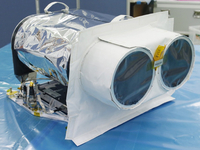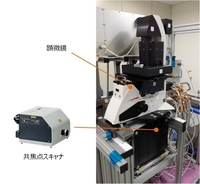Cargo in the pressurized Logistic Carrier (PLC)
Utilization/experiment related items
- Solid Combustion Experiment Module (SCEM)
-
The Solid Combustion Experiment Module (SCEM) is a device to be used for the FLARE project (Flammability Limits at Reduced Gravity Experiment). This project is implemented to scientifically determine the role of gravity in combustion phenomenon such as ignition of solid materials and spreading of flames on various solid materials in the ISS's environment without natural convection (microgravity environment).
- integrated Standard Imager for Microsatellites (iSIM) to be loaded on CubeSat (for private purposes)
-
The integrated Standard Imager for Microsatellites (iSIM) is an earth observation camera being developed by a Spanish space venture company, Satlantis, which will be mounted on CubeSats or microsatellites. For the purpose of on-orbit demonstration, an iSIM will be installed on the IVA-replaceable Small Exposed Experiment Platform (i-SEEP). It is capable of taking high-resolution pictures of the Earth surface. The Tsukuba Space Center will send a schedule file to the on-orbit computer for the iSIM's automatic reading. The iSIM will take pictures according to the schedule. Pictures taken will be downlinked to the Tsukuba Space Center and transferred to Satlantis.
- Materials related to space media business (for private purposes)
-
The basic components of the studio constructed for demonstration are a window of the Japanese Experiment Module "Kibo" facing the Earth (main view) and nearby tablet terminals. Technical demonstration tests are conducted of the world unprecedented face-to-face two-way live streaming system by the world unprecedented, using a new dedicated ISS/Earth data communication protocol and a newly developed two-way communication application that can be activated in a short time. Demonstration tests in view of commercialization also are conducted. These tests are supported by some of the devices available on "Kibo." The HTV9 (KOUNOTORI9) transports materials including an ND filter (used for adjusting the luminance between images on the tablet screen and the Earth image seen through the window), cables and fixing devices, which are indispensable for opening the Kibo Space Broadcasting Station as a space media business and exploitable for various future projects.
Reference:
- A live imaging system "Confocal Space Microscopy" ("COSMIC")
-
The Confocal Space Microscopy (COSMIC) is a microscope system for life science experiment, slated to be installed on the Japanese Experiment Module (JEM) "Kibo." This system is capable of performing an advanced live imaging with fluorescence imaging, confocal imaging and autofocus. Its live imaging performance level under microgravity is as high as that of advanced life science technologies on the ground.
Acquisition of techniques for three-dimensional culturing that may be applied to regenerative medicine and description of the cellular-level gravity sensing mechanism might be main research fields of future life sciences on the JEM. Three-dimensional imaging of the three-dimensional structure of cellular tissues and accurate gravity response analysis by live imaging in in-orbit environment will play important roles in life science researches. Description of the cellular gravity response mechanism through space experiments using COSMIC will hopefully mark a great step for a progress of basic life sciences and regenerative medicine.
References (in Japanese):
- "Space Avatar" business (for private purposes)
-
The space avatar was launched to the ISS aboard the HTV9(KOUNOTORI9) in May 2020 and will be installed near a window on the Kibo module. In a world's first, the general public will be able to remotely operate this onboard system and view its real-time video stream from a public, non-JAXA facility in Tokyo. Individuals operating the system from the ground will have the unique experience of viewing the Earth from aboard the ISS.
This project is a direct output of the "AVATAR X" program which was launched in September of 2018 under the JAXA Space Innovation through Partnership and Co-creation initiative ("J-SPARC").
Reference
- Fresh food
-
HTV9 will also deliver fresh food.
- ISS battery Orbital Replacement Units (ORUs)
-
Following HTV6, HTV7, and HTV8, HTV9 delivers new lithium ion batteries for the ISS. The batteries are delivered on the Exposed Pallet (EP), placed on the Unpressurized Logistic Carrier (ULC).
The new six battery Orbital Replacement Units (ORUs) consist new lithium-ion battery cells manufactured by a Japanese company.
The nickel-hydrogen batteries currently used on the ISS are becoming old. The extension of ISS operations becomes possible with the supply of Japanese lithium-ion battery cells. Only the HTV is capable of delivering six battery ORUs at one time, and thus plays an important role in continuous ISS operations.
Cargo for the ISS crew
Cargo on the Unpressurized Logistics Carrier (ULC)
*All times are Japan Standard Time (JST. UTC + 9 hours)






